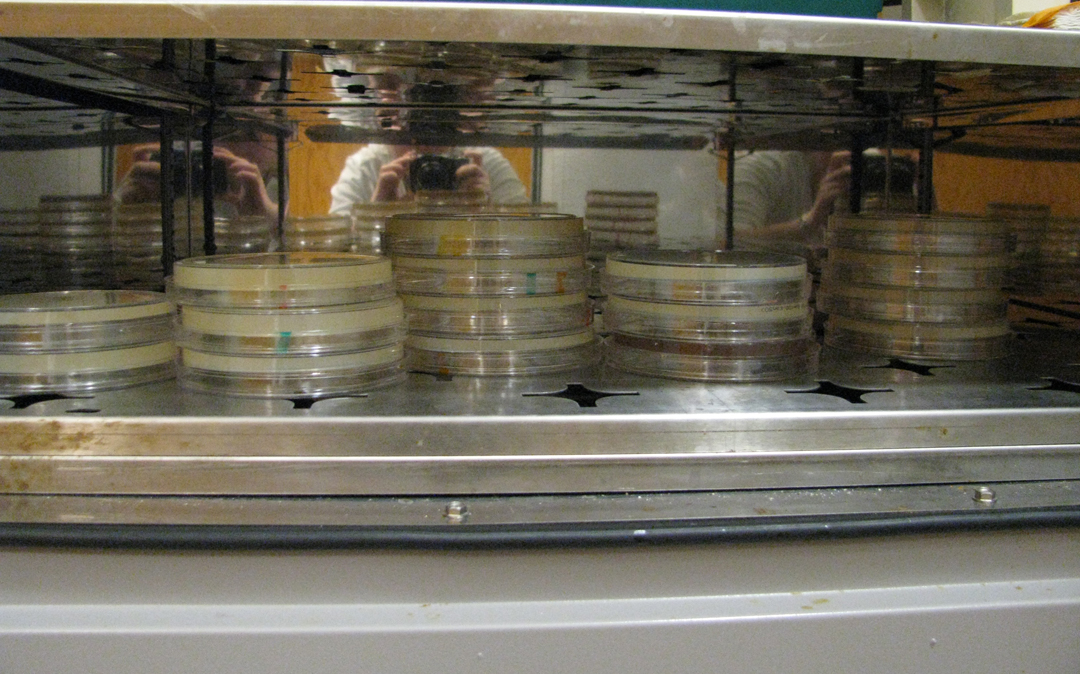Creating the Distribution
Contents
Source Plate
The simplest definition of a Source Plate is a list of parts that are to be included into a distribution. Parts are chosen and organized by antibiotic resistance, and a source plate holding all this data is created on the Registry.
Populating
How do we decide what parts go into a distribution? First, we take parts from previous years that all have passed our quality control: sequencing, AB test plates, and restriction digests. Sometimes a source plate may be a copy of a previous plate. For example, SP 3001 is an exact copy of SP 2001. Other times we will cherry pick parts to create a new source plate.
Growing
When we create a physical Source Plate for the Registry's stocks and the distribution we first prepare three types of 96 well plates.
If we are copying a previous Source Plate, we may thaw down that SP's glycerol, and directly inoculate using a 2ul pin tool. If we cherry picking the parts from various sources (different Source Plates, submissions, etc) we will pick single colonies from a streaking, and create a staging plate.
Antibiotic testing plates
Four antibiotic testing plates are prepared, testing a part's known resistance against ampicillin, kanamycin, chloramphenicol, and tetracycline. The plates are grown overnight (16hrs) at 37C in our shaker incubator, and pelleted at 3500rpm for 5min. The plates are then photographed and uploaded to their respective Source Plate page.
Glycerol plates
Two glycerol plates containing LB Broth w/ 10% glycerol and appropriate antibiotic are prepared for the long term storage of the parts.
Miniprep plates
Two miniprep plates are inoculated, and incubated overnight at 37C (16hrs) on the MacConnell shaker. The next day, the plates are pelleted, and imaged and uploaded to their respective Source Plate page. The plates undergo miniprepping. The liquid DNA is separated into separate plates for sequencing, restriction digests and a reserve.
Quality Control Process
For this year's distribution we have carried over our extensive quality control measures conducted in 2008, in order to better ensure the accuracy of DNA parts sent to the iGEM 2009 teams. The QC process from 2008 examined each part in the Registry to determine if the plasmid and the part within are correct according to the documentation provided with each submission. The results for each part were then posted on the Registry's DNA repository page, allowing iGEM teams to access this information before using the submissions to create their own parts. This year's DNA Parts Kits contains hundreds of these high quality parts from previous years, as well as the team favorites from 2008, which have all undergone the same quality control measures before inclusion into the 2009 kit.
Streaking for Single Colonies
Once we decided which part would be assigned to each plate and created the full layout for the distribution, bacterial stocks containing the parts were streaked for single colonies on petri dishes containing the appropriate antibiotic.
Parts in the Registry prior to iGEM 2008, that had all undergone an extensive quality control process in 2008, were kept in glycerol stocks in the Registry's -80C freezer, where they were directly streaked onto petri dishes with appropriate antibiotic and grown overnight at 37C.
The rest of the parts used for our distribution - the favorites of the iGEM 2008 teams - were received as DNA and transformed into competent cells. Once transformed, they were also plated onto petri dishes with their appropriate antibiotic and allowed to incubate overnight at 37C.
Preparation and Inoculation from Staging Plate
The next morning (16 hours of incubation), the petri dishes were removed from the incubator and a single colony was picked from each plate, using a pipette tip. The colony was then transferred to its corresponding well of a 96 deep well plate filled with the appropriate antibiotic broth (60ul in each well), and mixed thoroughly. This series of inoculations created a 96 well staging plate for the bioparts.
Once all 96 wells of the staging plate were inoculated with single colonies, a 5.0ul pin tool replicator was used to then inoculate from the staging plate to antibiotic testing plates,miniprep plates, and glycerol plates. The plates were then incubated at 37C for 16 hours, and 10 hours for the glycerols.

